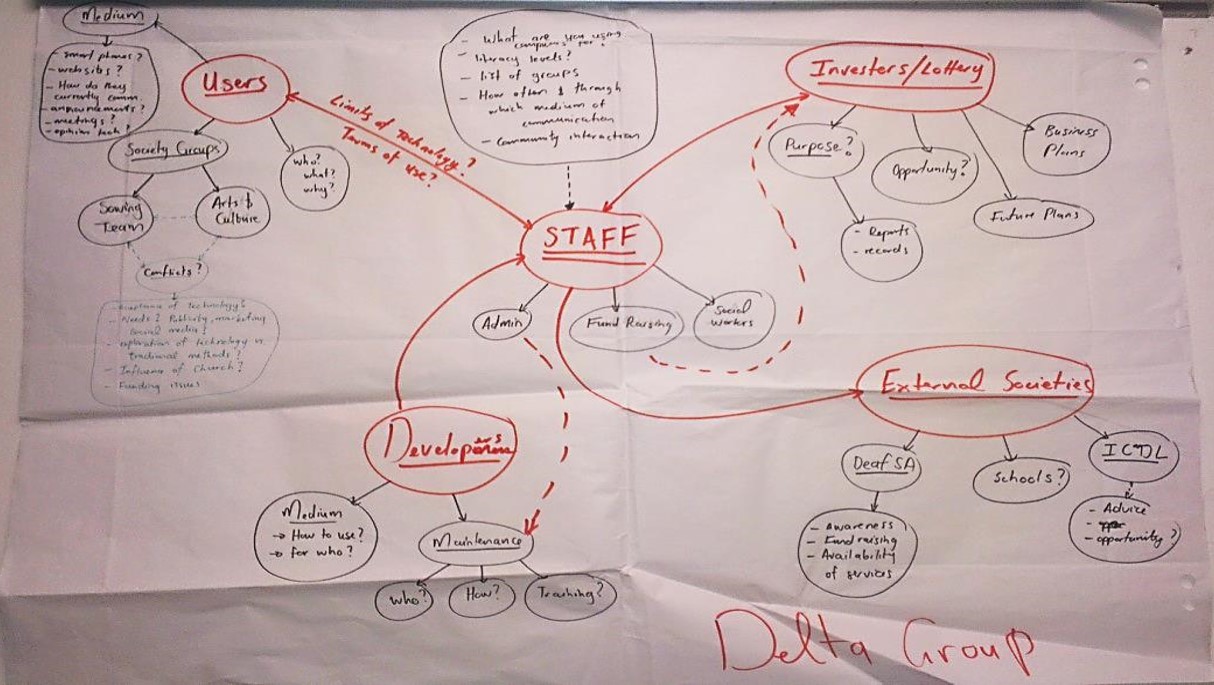
| Starting out on Community-Based Co-Design? Firstly “Don't Panic”. Some of the things you have to do first depend on first doing things that you only do later. As pointed out above, this is normal for wicked problems. Just do your best, use your common sense and ask your advisor. |
|
Your first actions in community-based research is to recognize groups of stakeholders. Questions that you need to answer include: Who are the stakeholders and what do they want? What can they give? What do you know, what do you need to know? Use knowledge (from key informants) and employ your own empathy. Are there any conflicts in interest? Draw a mind map of how people and groups fit together. Make maps with connections and conflicts; each stakeholder is a unit, they are connected by lines/arrows. See www.free-power-point-templates.com/articles/stakeholder-map-template. Within these identify gatekeepers: people or associations whom you have to satisfy in order to work with the stakeholders. Please consider how all the diverse needs might be investigated. Get permission to do the work you need to do. You will need intermediaries, people who can support your work and act as a go-between and perhaps champion your work. A good next step is to hold a community meeting, either with leaders (e.g., elders) or a general meeting. Of course this is already part of your data gathering (a kind of focus group). Your aim is to get buy-in from the whole community. |
Early Data GatheringEarly stages of eliciting user requirements you can use techniques you learnt from human-computer interaction (HCI) courses and textbooks. Four major data gathering methods that you can use are: interviews, observation and storytelling. Questionnaires are of very limited use in ICT4D research. Techniques can be combined depending on study focus, participants, nature of technique and available resources Set clear goals ahead of time and choose participants from the stakeholders that you have identified. Use different techniques in order to get triangulation on the issues to be addressed. For this to be successful you must build up a good and respectful relationship participants. Finally always try out your ideas in a pilot process with others who can play the role of participants and give you feedback (e.g., try it with other students). Observation is useful and may be direct or indirect, in the field or in controlled setting. Important Points on EthicsKeep videos private, do not load them into the internet/clouds. Keep all personal data provided confidential and secure. Anonymise any pictures of people and always ask permission before taking any pictures or recording audio or video. |
Interviews
Interviews may be structured, semi-structured or unstructured. You can introduce your prototype devices or propose a usage scenario when you conduct an interview.
- Unstructured – are not directed by a script. Rich but not replicable.
- Structured – are tightly scripted, often like a questionnaire. Replicable but may lack richness.
- Semi-structured – guided by a script but interesting issues can be explored in more depth. Can provide a good balance between richness and replicability.
Interview questions can be of two types:
- ‘closed questions’ have a predetermined answer format, e.g., ‘yes’ or ‘no’ (are easier to analyse)
- ‘open questions’ do not have a predetermined format
Avoid:
- Long questions
- Compound sentences - split them into two
- Jargon and language that the interviewee may not understand
- Leading questions that make assumptions e.g., why do you like …?
- Unconscious biases e.g., gender stereotypes
Running the interview
- Introduction – introduce yourself, explain the goals of the interview, reassure about the ethical issues, ask to record, present any informed consent form.
- Warm-up – make first questions easy and non-threatening.
- Main body – present questions in a logical order
- A cool-off period – include a few easy questions to defuse tension at the end
- Closure – thank interviewee, signal the end,
A focus group can also be regarded as a group interview. They require careful preparation, decide on questions and if there is more than one person helping run a focus group assign one (prime) spokesperson per group. Others concentrate on listening and taking notes. If you are recoding a video (having obtained permission beforehand!) then it is useful to note the time at which significant events take place in order to go back to the right place in the video.
